YAMAHA FJR1300A 2013 Workshop Manual
Manufacturer: YAMAHA, Model Year: 2013, Model line: FJR1300A, Model: YAMAHA FJR1300A 2013Pages: 118, PDF Size: 3.28 MB
Page 51 of 118
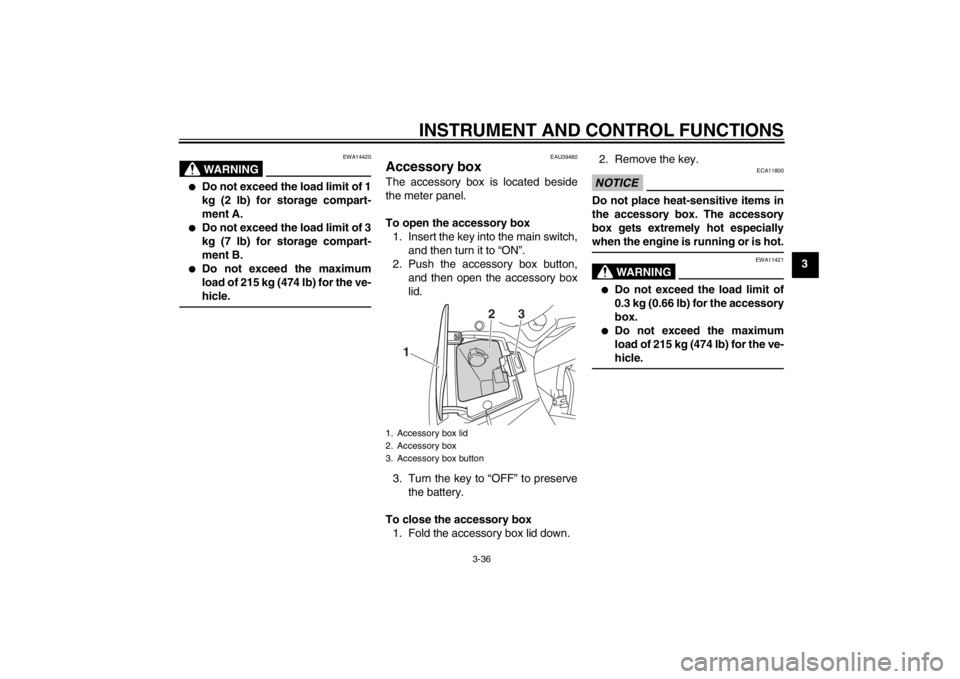
INSTRUMENT AND CONTROL FUNCTIONS
3-36
3
WARNING
EWA14420
●
Do not exceed the load limit of 1
kg (2 lb) for storage compart-
ment A.
●
Do not exceed the load limit of 3
kg (7 lb) for storage compart-
ment B.
●
Do not exceed the maximum
load of 215 kg (474 lb) for the ve-
hicle.
EAU39480
Accessory box The accessory box is located beside
the meter panel.
To open the accessory box1. Insert the key into the main switch, and then turn it to “ON”.
2. Push the accessory box button, and then open the accessory box
lid.
3. Turn the key to “OFF” to preserve the battery.
To close the accessory box 1. Fold the accessory box lid down. 2. Remove the key.
NOTICE
ECA11800
Do not place heat-sensitive items in
the accessory box. The accessory
box gets extremely hot especially
when the engine is running or is hot.
WARNING
EWA11421
●
Do not exceed the load limit of
0.3 kg (0.66 lb) for the accessory
box.
●
Do not exceed the maximum
load of 215 kg (474 lb) for the ve-
hicle.
1. Accessory box lid
2. Accessory box
3. Accessory box button
1
2
3
U1MCE0E0.book Page 36 Thursday, July 19, 2012 6:59 PM
Page 52 of 118
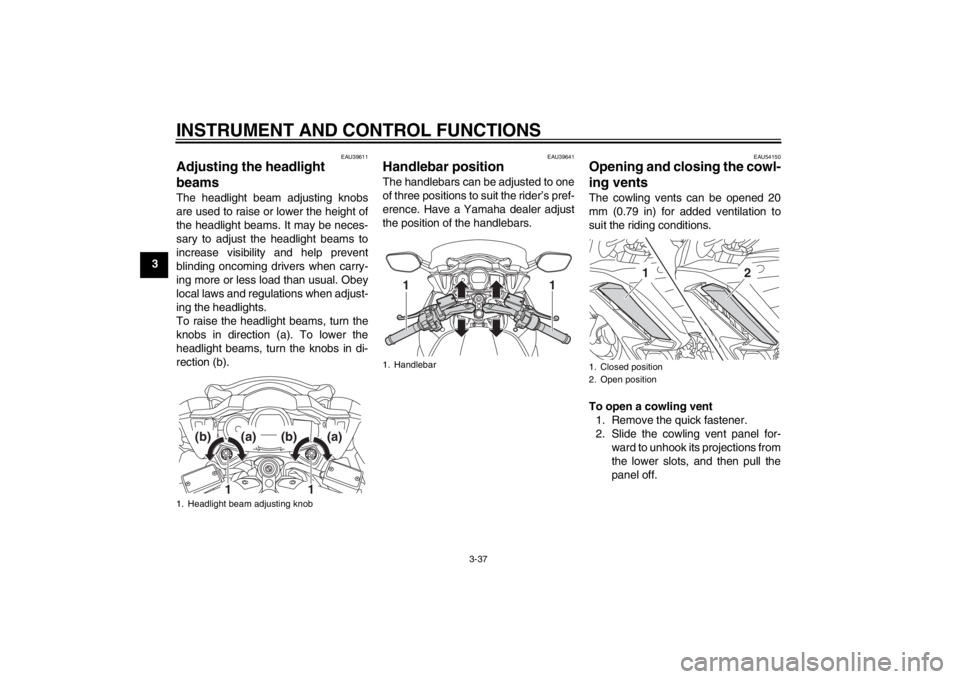
INSTRUMENT AND CONTROL FUNCTIONS
3-37
3
EAU39611
Adjusting the headlight
beams The headlight beam adjusting knobs
are used to raise or lower the height of
the headlight beams. It may be neces-
sary to adjust the headlight beams to
increase visibility and help prevent
blinding oncoming drivers when carry-
ing more or less load than usual. Obey
local laws and regulations when adjust-
ing the headlights.
To raise the headlight beams, turn the
knobs in direction (a). To lower the
headlight beams, turn the knobs in di-
rection (b).
EAU39641
Handlebar position The handlebars can be adjusted to one
of three positions to suit the rider’s pref-
erence. Have a Yamaha dealer adjust
the position of the handlebars.
EAU54150
Opening and closing the cowl-
ing vents The cowling vents can be opened 20
mm (0.79 in) for added ventilation to
suit the riding conditions.
To open a cowling vent1. Remove the quick fastener.
2. Slide the cowling vent panel for- ward to unhook its projections from
the lower slots, and then pull the
panel off.
1. Headlight beam adjusting knob
1
1
(b)
(a)
(b)
(a)
1. Handlebar
11
1. Closed position
2. Open position
1
2
U1MCE0E0.book Page 37 Thursday, July 19, 2012 6:59 PM
Page 53 of 118
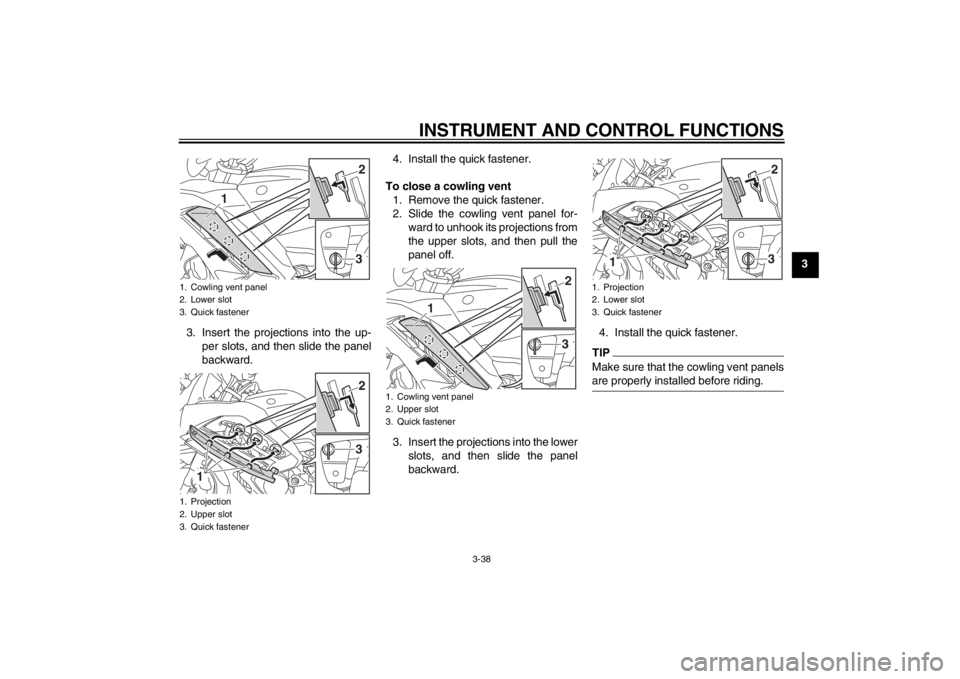
INSTRUMENT AND CONTROL FUNCTIONS
3-38
3
3. Insert the projections into the up- per slots, and then slide the panel
backward. 4. Install the quick fastener.
To close a cowling vent 1. Remove the quick fastener.
2. Slide the cowling vent panel for- ward to unhook its projections from
the upper slots, and then pull the
panel off.
3. Insert the projections into the lower slots, and then slide the panel
backward. 4. Install the quick fastener.
TIPMake sure that the cowling vent panels
are properly installed before riding.
1. Cowling vent panel
2. Lower slot
3. Quick fastener
1. Projection
2. Upper slot
3. Quick fastener
3
1
2
1
32
1. Cowling vent panel
2. Upper slot
3. Quick fastener
3
1
2
1. Projection
2. Lower slot
3. Quick fastener
1
32
U1MCE0E0.book Page 38 Thursday, July 19, 2012 6:59 PM
Page 54 of 118
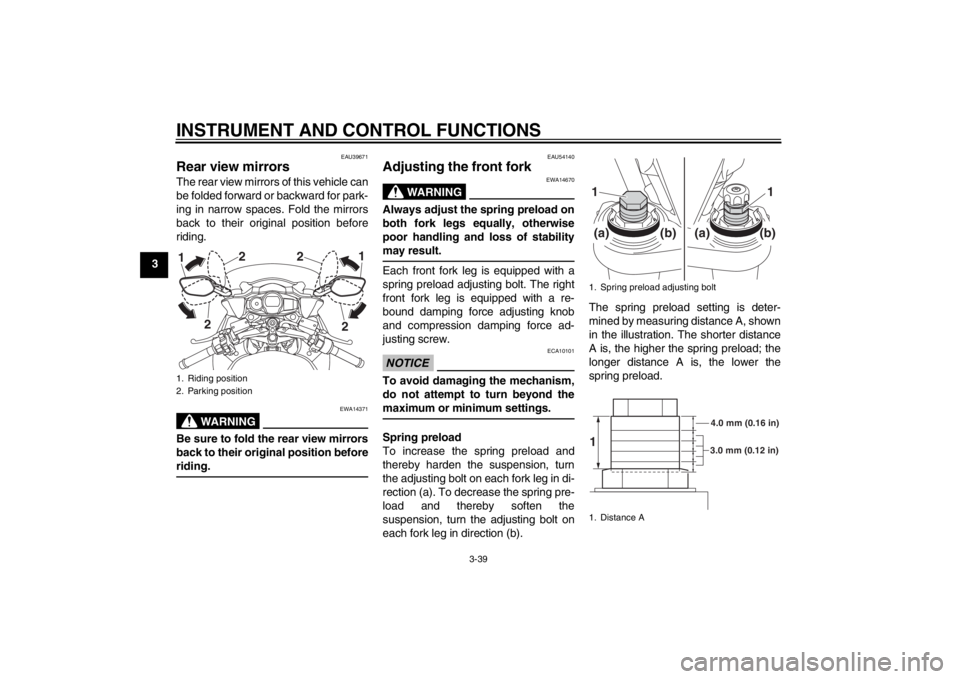
INSTRUMENT AND CONTROL FUNCTIONS
3-39
3
EAU39671
Rear view mirrors The rear view mirrors of this vehicle can
be folded forward or backward for park-
ing in narrow spaces. Fold the mirrors
back to their original position before
riding.
WARNING
EWA14371
Be sure to fold the rear view mirrors
back to their original position before
riding.
EAU54140
Adjusting the front fork
WARNING
EWA14670
Always adjust the spring preload on
both fork legs equally, otherwise
poor handling and loss of stability
may result.Each front fork leg is equipped with a
spring preload adjusting bolt. The right
front fork leg is equipped with a re-
bound damping force adjusting knob
and compression damping force ad-
justing screw.NOTICE
ECA10101
To avoid damaging the mechanism,
do not attempt to turn beyond the
maximum or minimum settings.Spring preload
To increase the spring preload and
thereby harden the suspension, turn
the adjusting bolt on each fork leg in di-
rection (a). To decrease the spring pre-
load and thereby soften the
suspension, turn the adjusting bolt on
each fork leg in direction (b).The spring preload setting is deter-
mined by measuring distance A, shown
in the illustration. The shorter distance
A is, the higher the spring preload; the
longer distance A is, the lower the
spring preload.
1. Riding position
2. Parking position
2
2
1
2 2
1
1. Spring preload adjusting bolt
1. Distance A
(a)
(b)1
1(a)
(b)
4.0 mm (0.16 in)
3.0 mm (0.12 in)
1
U1MCE0E0.book Page 39 Thursday, July 19, 2012 6:59 PM
Page 55 of 118
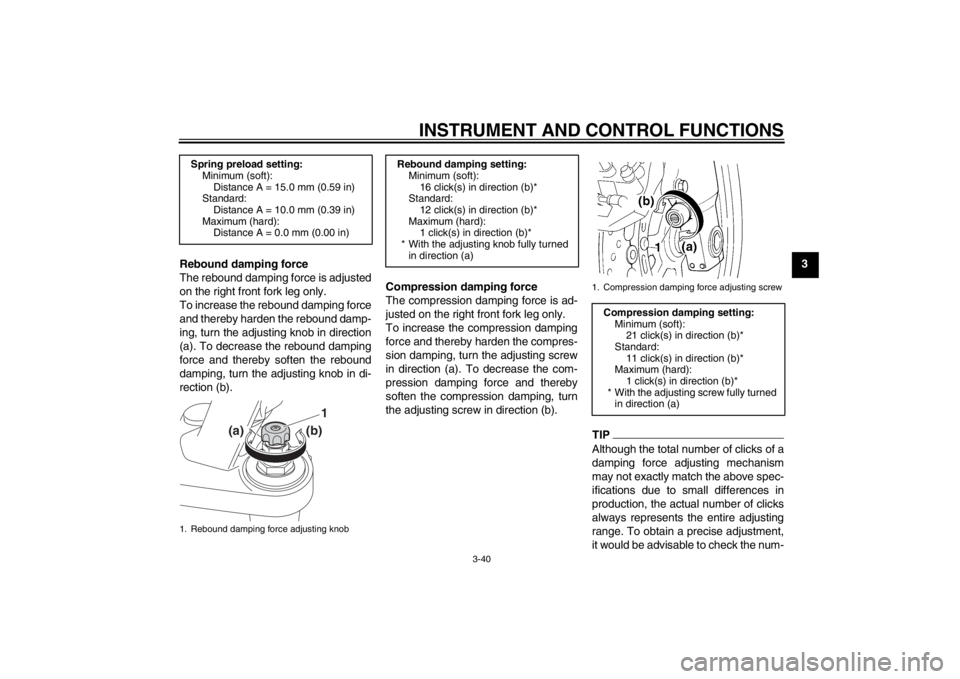
INSTRUMENT AND CONTROL FUNCTIONS
3-40
3
Rebound damping force
The rebound damping force is adjusted
on the right front fork leg only.
To increase the rebound damping force
and thereby harden the rebound damp-
ing, turn the adjusting knob in direction
(a). To decrease the rebound damping
force and thereby soften the rebound
damping, turn the adjusting knob in di-
rection (b). Compression damping force
The compression damping force is ad-
justed on the right front fork leg only.
To increase the compression damping
force and thereby harden the compres-
sion damping, turn the adjusting screw
in direction (a). To decrease the com-
pression damping force and thereby
soften the compression damping, turn
the adjusting screw in direction (b).
TIPAlthough the total number of clicks of a
damping force adjusting mechanism
may not exactly match the above spec-
ifications due to small differences in
production, the actual number of clicks
always represents the entire adjusting
range. To obtain a precise adjustment,
it would be advisable to check the num-
Spring preload setting:
Minimum (soft):
Distance A = 15.0 mm (0.59 in)
Standard:
Distance A = 10.0 mm (0.39 in)
Maximum (hard): Distance A = 0.0 mm (0.00 in)1. Rebound damping force adjusting knob
(a)
(b)
1
Rebound damping setting: Minimum (soft):
16 click(s) in direction (b)*
Standard:
12 click(s) in direction (b)*
Maximum (hard): 1 click(s) in direction (b)*
* With the adjusting knob fully turned in direction (a)
1. Compression damping force adjusting screw
Compression damping setting: Minimum (soft): 21 click(s) in direction (b)*
Standard: 11 click(s) in direction (b)*
Maximum (hard):
1 click(s) in direction (b)*
* With the adjusting screw fully turned in direction (a)
U1MCE0E0.book Page 40 Thursday, July 19, 2012 6:59 PM
Page 56 of 118
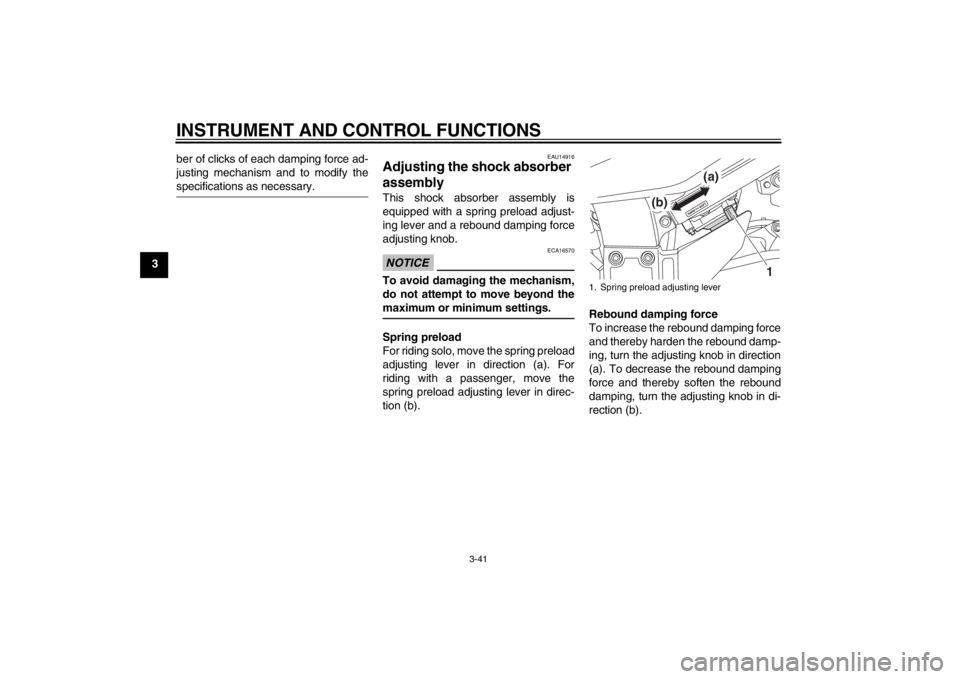
INSTRUMENT AND CONTROL FUNCTIONS
3-41
3ber of clicks of each damping force ad-
justing mechanism and to modify the
specifications as necessary.
EAU14916
Adjusting the shock absorber
assembly This shock absorber assembly is
equipped with a spring preload adjust-
ing lever and a rebound damping force
adjusting knob.NOTICE
ECA16570
To avoid damaging the mechanism,
do not attempt to move beyond the
maximum or minimum settings.Spring preload
For riding solo, move the spring preload
adjusting lever in direction (a). For
riding with a passenger, move the
spring preload adjusting lever in direc-
tion (b).
Rebound damping force
To increase the rebound damping force
and thereby harden the rebound damp-
ing, turn the adjusting knob in direction
(a). To decrease the rebound damping
force and thereby soften the rebound
damping, turn the adjusting knob in di-
rection (b).
1. Spring preload adjusting lever
1
(b)
(a)
U1MCE0E0.book Page 41 Thursday, July 19, 2012 6:59 PM
Page 57 of 118
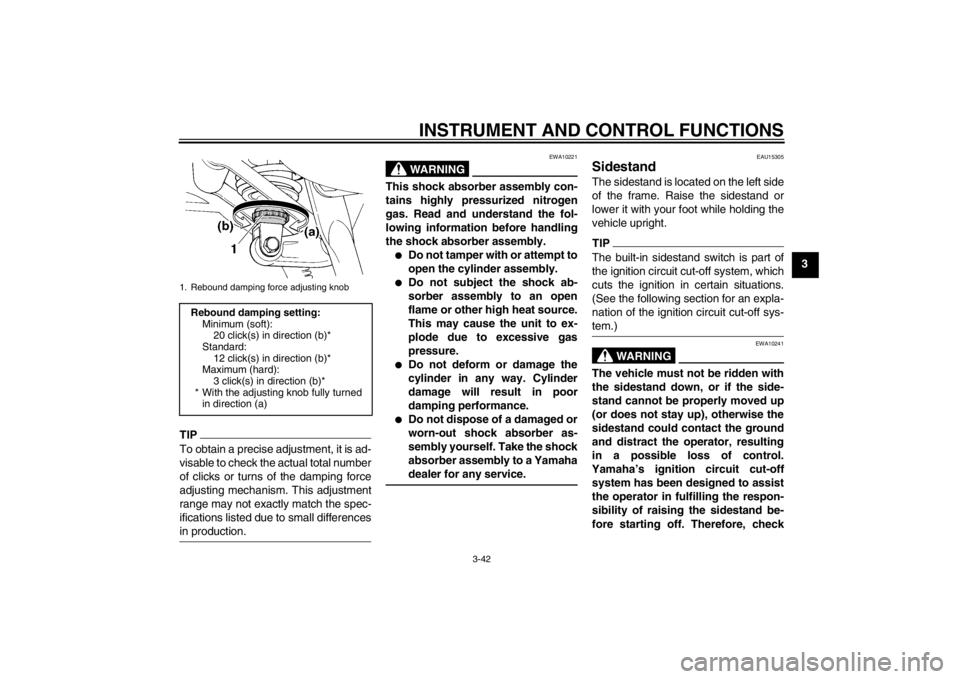
INSTRUMENT AND CONTROL FUNCTIONS
3-42
3
TIPTo obtain a precise adjustment, it is ad-
visable to check the actual total number
of clicks or turns of the damping force
adjusting mechanism. This adjustment
range may not exactly match the spec-
ifications listed due to small differences
in production.
WARNING
EWA10221
This shock absorber assembly con-
tains highly pressurized nitrogen
gas. Read and understand the fol-
lowing information before handling
the shock absorber assembly.●
Do not tamper with or attempt to
open the cylinder assembly.
●
Do not subject the shock ab-
sorber assembly to an open
flame or other high heat source.
This may cause the unit to ex-
plode due to excessive gas
pressure.
●
Do not deform or damage the
cylinder in any way. Cylinder
damage will result in poor
damping performance.
●
Do not dispose of a damaged or
worn-out shock absorber as-
sembly yourself. Take the shock
absorber assembly to a Yamaha
dealer for any service.
EAU15305
Sidestand The sidestand is located on the left side
of the frame. Raise the sidestand or
lower it with your foot while holding the
vehicle upright.TIPThe built-in sidestand switch is part of
the ignition circuit cut-off system, which
cuts the ignition in certain situations.
(See the following section for an expla-
nation of the ignition circuit cut-off sys-
tem.)
WARNING
EWA10241
The vehicle must not be ridden with
the sidestand down, or if the side-
stand cannot be properly moved up
(or does not stay up), otherwise the
sidestand could contact the ground
and distract the operator, resulting
in a possible loss of control.
Yamaha’s ignition circuit cut-off
system has been designed to assist
the operator in fulfilling the respon-
sibility of raising the sidestand be-
fore starting off. Therefore, check
1. Rebound damping force adjusting knobRebound damping setting:Minimum (soft):20 click(s) in direction (b)*
Standard: 12 click(s) in direction (b)*
Maximum (hard):
3 click(s) in direction (b)*
* With the adjusting knob fully turned in direction (a)
U1MCE0E0.book Page 42 Thursday, July 19, 2012 6:59 PM
Page 58 of 118

INSTRUMENT AND CONTROL FUNCTIONS
3-43
3this system regularly and have a
Yamaha dealer repair it if it does not function properly.
EAU54490
Ignition circuit cut-off system The ignition circuit cut-off system (com-
prising the sidestand switch, clutch
switch and neutral switch) has the fol-
lowing functions.●
It prevents starting when the trans-
mission is in gear and the side-
stand is up, but the clutch lever is
not pulled.
●
It prevents starting when the trans-
mission is in gear and the clutch le-
ver is pulled, but the sidestand is
still down.
●
It cuts the running engine when the
transmission is in gear and the
sidestand is moved down.
Periodically check the operation of the
ignition circuit cut-off system according
to the following procedure.
U1MCE0E0.book Page 43 Thursday, July 19, 2012 6:59 PM
Page 59 of 118
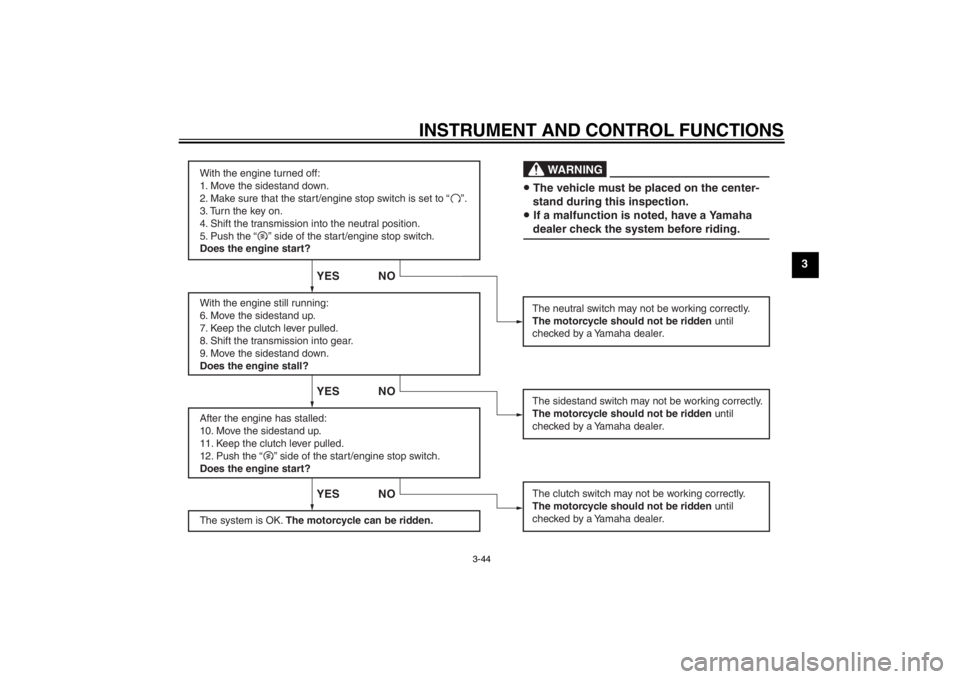
INSTRUMENT AND CONTROL FUNCTIONS
3-44
3
With the engine turned off:
1. Move the sidestand down.
2. Make sure that the start/engine stop switch is set to “ ”.
3. Turn the key on.
4. Shift the transmission into the neutral position.
5. Push the “ ” side of the start/engine stop switch.
Does the engine start?
With the engine still running:
6. Move the sidestand up.
7. Keep the clutch lever pulled.
8. Shift the transmission into gear.
9. Move the sidestand down.
Does the engine stall?
After the engine has stalled:
10. Move the sidestand up.
11. Keep the clutch lever pulled.
12. Push the “ ” side of the start/engine stop switch.
Does the engine start?
The system is OK. The motorcycle can be ridden.
YES NO YES NO YES NO
The neutral switch may not be working correctly.
The motorcycle should not be ridden until
checked by a Yamaha dealer.
The clutch switch may not be working correctly.
The motorcycle should not be ridden until
checked by a Yamaha dealer.The sidestand switch may not be working correctly.
The motorcycle should not be ridden until
checked by a Yamaha dealer. The vehicle must be placed on the center-
stand during this inspection.If a malfunction is noted, have a Yamaha
dealer check the system before riding.
WA R N I N G
U1MCE0E0.book Page 44 Thursday, July 19, 2012 6:59 PM
Page 60 of 118
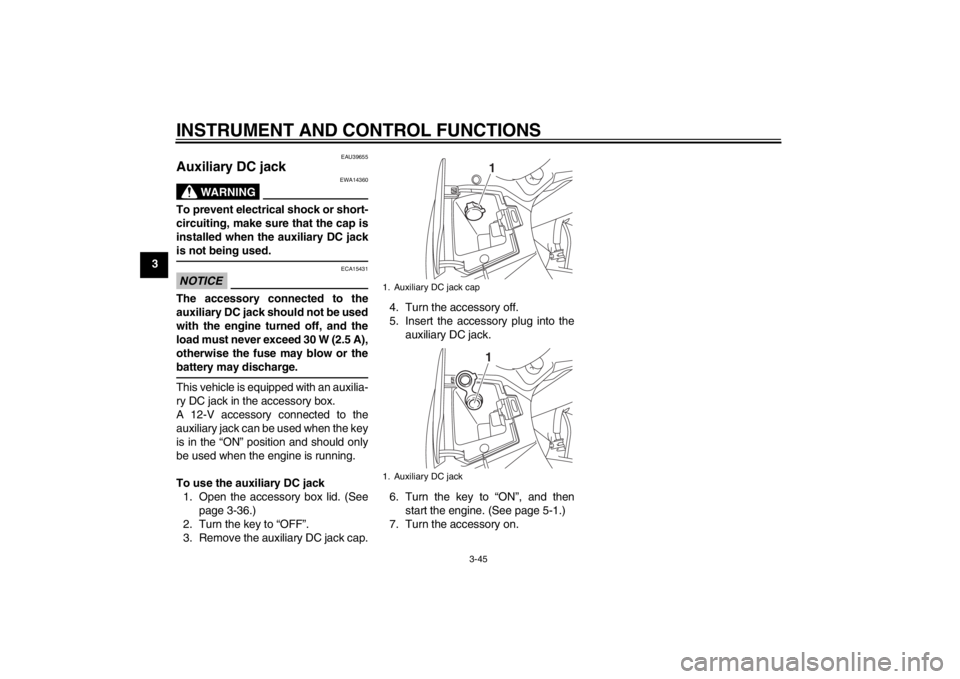
INSTRUMENT AND CONTROL FUNCTIONS
3-45
3
EAU39655
Auxiliary DC jack
WARNING
EWA14360
To prevent electrical shock or short-
circuiting, make sure that the cap is
installed when the auxiliary DC jack
is not being used.NOTICE
ECA15431
The accessory connected to the
auxiliary DC jack should not be used
with the engine turned off, and the
load must never exceed 30 W (2.5 A),
otherwise the fuse may blow or the
battery may discharge.This vehicle is equipped with an auxilia-
ry DC jack in the accessory box.
A 12-V accessory connected to the
auxiliary jack can be used when the key
is in the “ON” position and should only
be used when the engine is running.
To use the auxiliary DC jack1. Open the accessory box lid. (See page 3-36.)
2. Turn the key to “OFF”.
3. Remove the auxiliary DC jack cap. 4. Turn the accessory off.
5. Insert the accessory plug into the
auxiliary DC jack.
6. Turn the key to “ON”, and then start the engine. (See page 5-1.)
7. Turn the accessory on.
1. Auxiliary DC jack cap
1. Auxiliary DC jack
11
U1MCE0E0.book Page 45 Thursday, July 19, 2012 6:59 PM